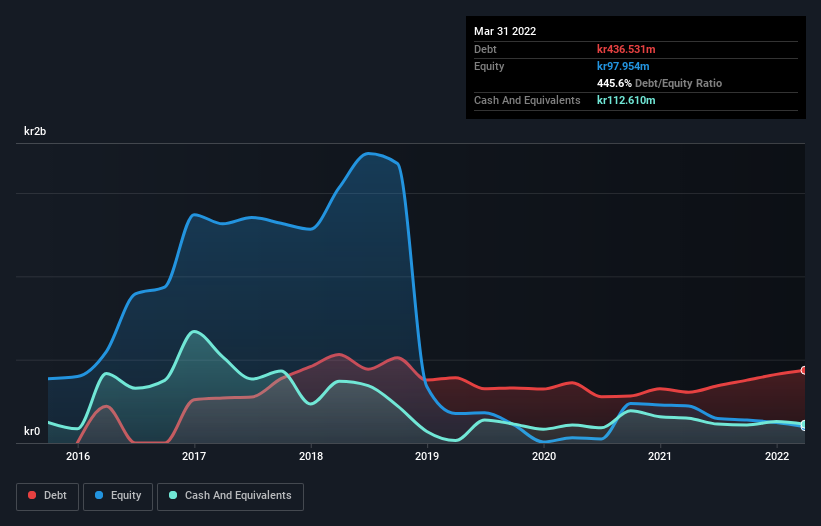
Howard Marks put it nicely when he said that, rather than worrying about share price volatility, 'The possibility of permanent loss is the risk I worry about... and every practical investor I know worries about.' So it seems the smart money knows that debt - which is usually involved in bankruptcies - is a very important factor, when you assess how risky a company is. We note that Starbreeze AB (publ) (STO:STAR B) does have debt on its balance sheet. But the more important question is: how much risk is that debt creating?
Why Does Debt Bring Risk?
Debt assists a business until the business has trouble paying it off, either with new capital or with free cash flow. In the worst case scenario, a company can go bankrupt if it cannot pay its creditors. However, a more common (but still painful) scenario is that it has to raise new equity capital at a low price, thus permanently diluting shareholders. Of course, debt can be an important tool in businesses, particularly capital heavy businesses. When we examine debt levels, we first consider both cash and debt levels, together.
See our latest analysis for Starbreeze
What Is Starbreeze's Net Debt?
The image below, which you can click on for greater detail, shows that at March 2022 Starbreeze had debt of kr436.5m, up from kr304.9m in one year. On the flip side, it has kr112.6m in cash leading to net debt of about kr323.9m.

A Look At Starbreeze's Liabilities
We can see from the most recent balance sheet that Starbreeze had liabilities of kr114.9m falling due within a year, and liabilities of kr453.4m due beyond that. On the other hand, it had cash of kr112.6m and kr37.3m worth of receivables due within a year. So it has liabilities totalling kr418.4m more than its cash and near-term receivables, combined.
This deficit is considerable relative to its market capitalization of kr697.3m, so it does suggest shareholders should keep an eye on Starbreeze's use of debt. Should its lenders demand that it shore up the balance sheet, shareholders would likely face severe dilution. The balance sheet is clearly the area to focus on when you are analysing debt. But you can't view debt in total isolation; since Starbreeze will need earnings to service that debt. So when considering debt, it's definitely worth looking at the earnings trend. Click here for an interactive snapshot.
Over 12 months, Starbreeze made a loss at the EBIT level, and saw its revenue drop to kr121m, which is a fall of 2.1%. We would much prefer see growth.
Caveat Emptor
Importantly, Starbreeze had an earnings before interest and tax (EBIT) loss over the last year. To be specific the EBIT loss came in at kr9.6m. Considering that alongside the liabilities mentioned above does not give us much confidence that company should be using so much debt. Quite frankly we think the balance sheet is far from match-fit, although it could be improved with time. However, it doesn't help that it burned through kr50m of cash over the last year. So in short it's a really risky stock. There's no doubt that we learn most about debt from the balance sheet. But ultimately, every company can contain risks that exist outside of the balance sheet. Case in point: We've spotted 1 warning sign for Starbreeze you should be aware of.
If, after all that, you're more interested in a fast growing company with a rock-solid balance sheet, then check out our list of net cash growth stocks without delay.
If you're looking to trade Starbreeze, open an account with the lowest-cost platform trusted by professionals, Interactive Brokers.
With clients in over 200 countries and territories, and access to 160 markets, IBKR lets you trade stocks, options, futures, forex, bonds and funds from a single integrated account.
Enjoy no hidden fees, no account minimums, and FX conversion rates as low as 0.03%, far better than what most brokers offer.
Sponsored ContentNew: Manage All Your Stock Portfolios in One Place
We've created the ultimate portfolio companion for stock investors, and it's free.
• Connect an unlimited number of Portfolios and see your total in one currency
• Be alerted to new Warning Signs or Risks via email or mobile
• Track the Fair Value of your stocks
Have feedback on this article? Concerned about the content? Get in touch with us directly. Alternatively, email editorial-team (at) simplywallst.com.
This article by Simply Wall St is general in nature. We provide commentary based on historical data and analyst forecasts only using an unbiased methodology and our articles are not intended to be financial advice. It does not constitute a recommendation to buy or sell any stock, and does not take account of your objectives, or your financial situation. We aim to bring you long-term focused analysis driven by fundamental data. Note that our analysis may not factor in the latest price-sensitive company announcements or qualitative material. Simply Wall St has no position in any stocks mentioned.
About OM:STAR B
Starbreeze
Develops, creates, publishes, and distributes PC and console games in Europe and North America.
Excellent balance sheet with reasonable growth potential.
Similar Companies
Market Insights
Community Narratives




